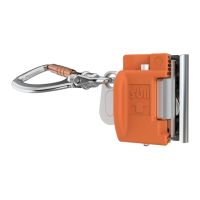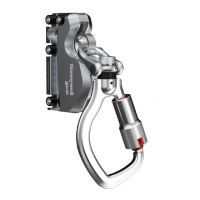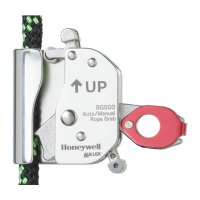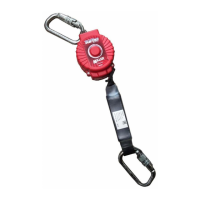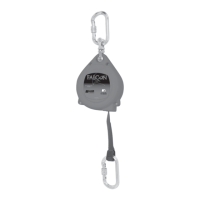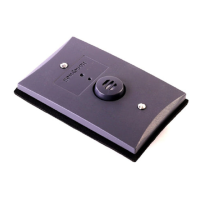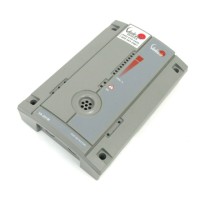
Do you have a question about the Honeywell VA201T and is the answer not in the manual?
| Brand | Honeywell |
|---|---|
| Model | VA201T |
| Category | Safety Equipment |
| Language | English |
Recommended procedure to improve sensor performance, use of zero air.
A confidence check to ensure gas detection system functionality.
Field calibration in controlled environment with certified reference devices.
May be required to adjust 4-20 mA output based on installation.
Turn the unit on for a minimum of five (5) minutes before calibration.
Steps to connect voltmeter, calibration adaptor, and tubing.
Procedure to set the zero potentiometer to a specific mV value.
Procedure to set the span potentiometer to the correct value.
Turn the unit on for a minimum of fifteen (15) minutes before calibration.
Steps to connect calibration adaptor, tubing, and regulator.
Procedure to set the zero value using menu navigation.
Procedure to set the span value using menu navigation.
Turn the unit on for a minimum of fifteen (15) minutes before calibration.
Steps to connect calibration adaptor, tubing, and regulator.
Procedure to set the zero value using buttons and menu.
Procedure to set the span value using buttons and menu.
Turn the unit on for a minimum of five (5) minutes before calibration.
Steps to connect the calibration adaptor and tubing.
Procedure to set the zero value using menu navigation.
Turn the unit on for a minimum of fifteen (15) minutes before calibration.
Steps to connect the calibration adapter and tubing.
Performing calibration remotely via VA301C controller.
Turn the unit on for a minimum of fifteen (15) minutes before calibration.
Steps to connect the regulator and tubing.
Performing calibration remotely via 301C controller.
Steps to plug adaptor, screw regulator, and connect tubing.
Procedure to set zero using LEDs and buttons.
Procedure to set zero using push buttons and menu.
Procedure to set span using push buttons and menu.
Lists necessary accessories like Flow Housing, test gas, and regulator.
Instruction to remove the sensor cap or accessory.
Instructions for fitting filters into the Flow Housing.
Attaching the Flow Housing to the certified sensor body.
Navigating the transmitter unit to the Calibration Menu.
Overview of options within the Calibration Menu.
Steps to initiate and perform zero calibration.
Process of the transmitter zeroing the sensor.
Steps to initiate and perform span calibration.
Applying span gas and waiting for stabilization.
Steps to set the sensor's zero value using menu.
Steps to set the sensor's span value using menu.
Importance of regular calibration for EC-F2 sensors.
Procedure for zero calibration of the EC-F2 sensor.
Procedure for span calibration of the EC-F2 sensor.
Information on barometric pressure effects on oxygen sensors.
Procedure for nominal calibration, adjusting span pot.
Procedure for zero calibration using certified gas.
Procedure for span calibration using calibration gas.
Importance of regular calibration for EC-F9 sensors.
Notes on zero calibration, pre-amp factory zeroed.
Procedure for span calibration of EC-F9 sensor.
Calibration recommendations and SMART-CELL function.
Steps to enter the zero/span mode.
Procedure for zero calibration.
Procedure for span calibration.
Steps to exit zero/span mode.
Loosening, pointing, and tightening components for alignment.
Notes on tightening screws and checking unit face for alignment.
Components and procedure for latch-style assembly alignment.
Components and procedure for bayonet-style assembly alignment.
Final alignment using adjustment screws.
Using the viewfinder for alignment and checking signal strength.
Steps to perform zero calibration after alignment.
Loosening, pointing, and tightening components for alignment.
Notes on tightening screws and checking unit face for alignment.
Components and procedure for latch-style assembly alignment.
Components and procedure for bayonet-style assembly alignment.
Final alignment using adjustment screws.
Connecting the SHC1 Handheld Interrogator and checking its mode.
Navigating SHC-1 menus and selecting system type.
Entering path length and performing self-test routine.
Understanding signal levels for optimal alignment and adjustments.
Optimizing alignment mechanically and locking it off.
Steps for performing zero calibration.
Steps to set the sensor's zero value using Nitrogen gas.
Steps to calibrate the CO2 sensor's span.
Entering the span gas concentration value.
Steps to calibrate the CO2 sensor's span using calibration gas.
Notes on automatic calibration for VOC sensors.
Steps to calibrate the temperature sensor.
Steps to calibrate the humidity sensor.
Procedure to calibrate the monitor's mA output for each channel.
Notes on calibration pots and manual reference.
Steps to perform zero calibration using buttons and LEDs.
Procedure to set the span level for the 4/20mA output.
Initial hardware connections for zero calibration.
Procedure to perform zero calibration using buttons and display.
Options for setting up bump tests or calibration.
Procedure to perform span calibration.
Procedure to define points for automatic flow compensations.
Equipment required for calibration with XNX.
Selecting the Gas Calibration option from the menu.
Performing zero calibration with XNX.
Steps to enter span gas concentration and apply gas.
Equipment required for calibration with SHC-1.
Performing a functional gas test (bump test).
Checking SHC-1 mode and navigating menus.
Selecting display mode and checking gas reading.
Detailed steps for performing a bump test.
Accessing calibration menu and performing zero calibration.
Steps to set gas concentration and apply span gas.
Lists necessary equipment for calibration.
Notes and cautions for zero and span calibration.
Steps to access the calibration mode using a magnet.
Confirming zero gas reading and saving calibration.
Selecting if span calibration is required.
Entering the span gas concentration value.
Applying span gas and confirming calibration.
Notes on answering "CELL/rEPL" for sensor replacement.
Specific considerations for calibrating Hydrogen Sulfide sensors.
On-site calibration recommendation for accuracy.
Ensuring power, checking for target gas, and applying zero gas.
Adjusting flow rate based on wind speed.
Adjusting span at the control card to read gas concentration.
Applying gas and adjusting span potentiometer.
Zero calibration using a 1LPM regulator and gas cylinder.
Zero calibration using a demand flow regulator.
Span calibration using a 1LPM regulator and span gas.
Span calibration using a demand flow regulator.
Span calibration using a gas bag with target sample gas.
Performing a bump test using calibration gas.
Notes on calibration modes and flow rates.
Steps for performing zero calibration.
Steps for performing span calibration.
Specific considerations for calibrating Hydrogen Sulfide sensors.
Performing a bump test using calibration gas.
Notes on calibration modes and flow rates.
Steps for performing zero calibration.
Steps for performing span calibration.
Adjusting span potentiometer to obtain correct gas concentration.
Accessing the Gas Calibration menu for zero/span/bump tests.
Safety warnings and calibration precautions.
Notes on stabilization, output inhibition, and gas cylinder use.
Steps for performing zero calibration.
Steps to enter span gas concentration and apply gas.
Steps to snap cup, attach hose, and adjust flow rate.
Specific considerations for H2S sensors and humidity.
Calibration procedures for combined systems.
Equipment required and steps for zero calibration.
Steps to enter span gas concentration and apply gas.
Lists products and their recommended flow rates for calibration.
Lists part numbers and descriptions for calibration kits.
Details calibration kits for EC-F2, EC-F3, EC-F9, IR-F9, E³Point.
Details calibration kits for 301W, GasPoint II/VA301D2, 301IRFS/S301D2.
Lists calibration kits for IAQPoint, SQN8x, Sensepoint Toxic, 705 Toxic, MPD.
